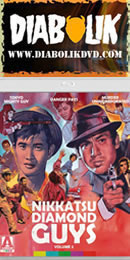
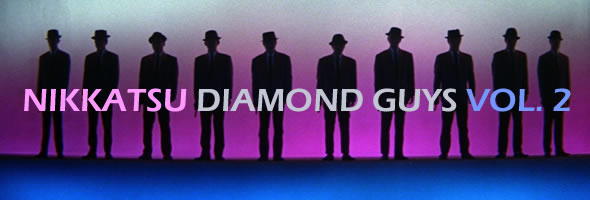
TOKYO MIGHTY GUY
Color, 1960, 79m.
Directed by Buichi Saitô Starring Akira Kobayashi, Ruriko Asaoka, Sanae Nakahara
DANGER PAYS
Color, 1962, 82m.
Directed by Kô Nakahira
Starring Jô Shishido, Hiroyuki Nagato, Ruriko Asaoka, Kojiro Kusanagi
MURDER UNINCORPORATED
Color, 1965, 85m.
Directed by Haruyasu Noguchi
Starring Kon Ohmura, Yoko Yamamoto, Kanbi Fujiyama, Jô Shishido, Minoru Shiraki, Bontaro Taira, Kiyoshi Hitomi, Hiroshi Hijikata, Yumiko Nogawa, Eiji Gô
Arrow (Blu-ray & DVD) (US/UK RA/RB HD) / WS (2.35:1) (16:9)
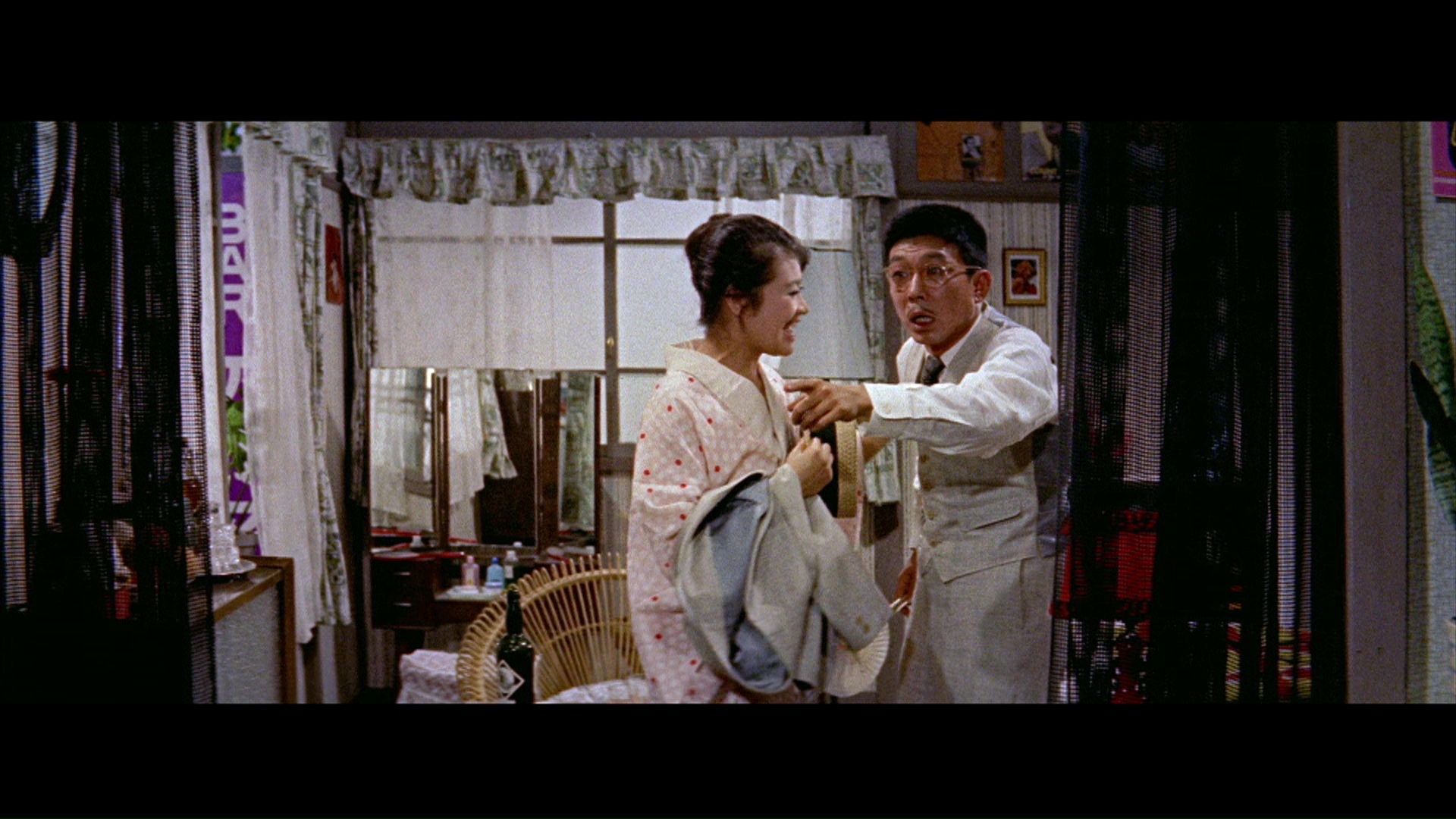
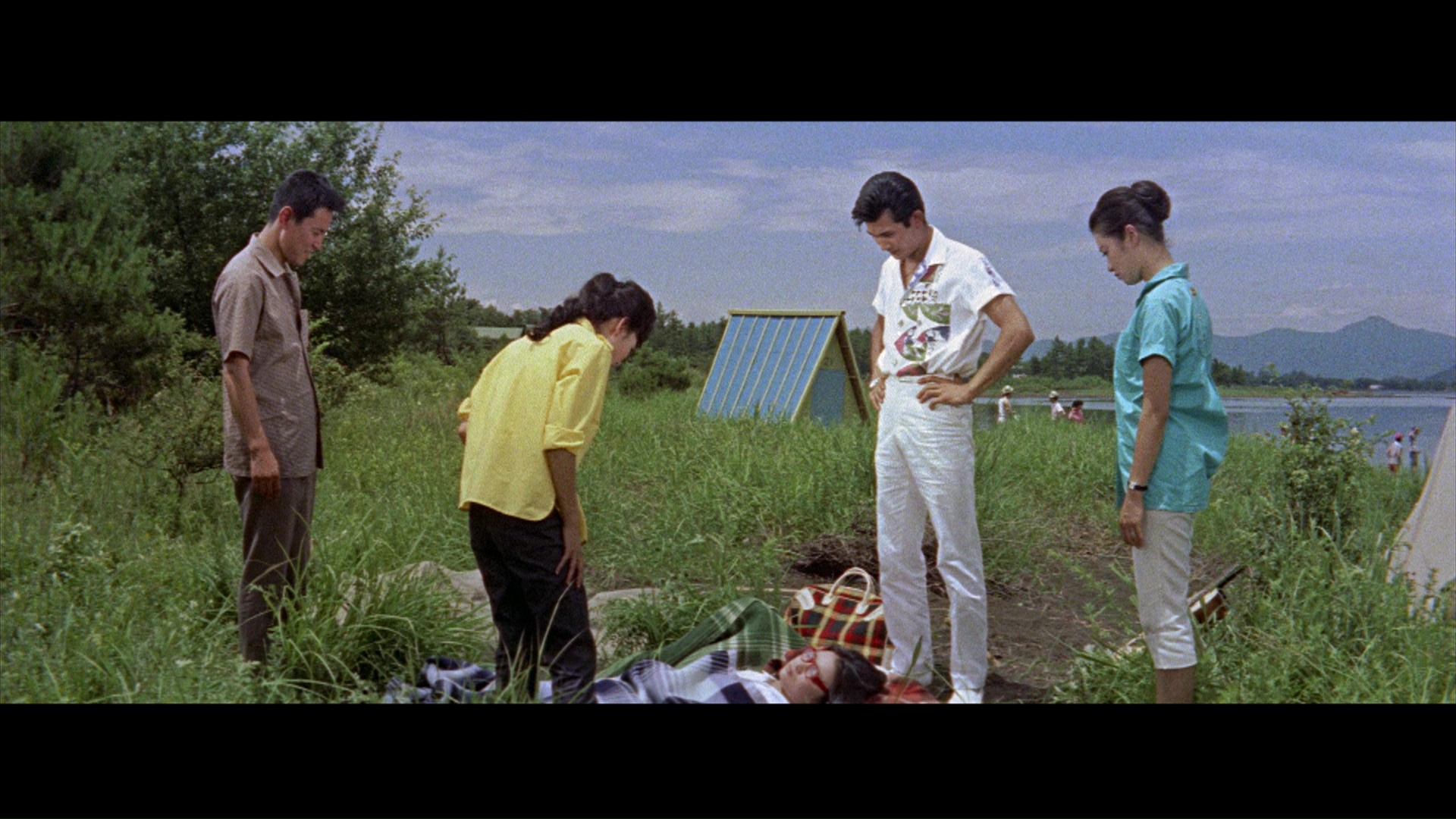 Arrow Films already promised a second volume in its Nikkatsu Diamonds Guys line even before the first one hit the streets, and anyone who indulged in that tasty triple helping of noir mayhem will find this set to be something even wilder and stranger. Picking up with the tone of the previous set’s The Wandering Guitarist, here we have a trio of very colorful, offbeat, and whimsically weird vehicles for some of Nikkatsu’s biggest leading men at the time, with color palettes worthy of classic Technicolor musicals.
Arrow Films already promised a second volume in its Nikkatsu Diamonds Guys line even before the first one hit the streets, and anyone who indulged in that tasty triple helping of noir mayhem will find this set to be something even wilder and stranger. Picking up with the tone of the previous set’s The Wandering Guitarist, here we have a trio of very colorful, offbeat, and whimsically weird vehicles for some of Nikkatsu’s biggest leading men at the time, with color palettes worthy of classic Technicolor musicals.
First up is Tokyo Mighty Guy, which begins with a charming hand-drawn homage to An American in Paris of all things. All of this sets up the return to Tokyo for enthusiastic young Jiro (Guitarist's Kobayashi), who’s been off learning all about fancy food in Paris when he's supposed to be studying to become a scientist. Despite his parents' wishes, he's back in Japan planning to open his own restaurant. Jiro loves showing off his slick French-speaking skills, but his choice of Ginza venue seems to be cursed when a former prime minister smashes his car into the storefront and the attention puts him in the cross hairs of some local "protectors" from the Typhoon Club-- and lusty women, ending up chased by one nice girl, a 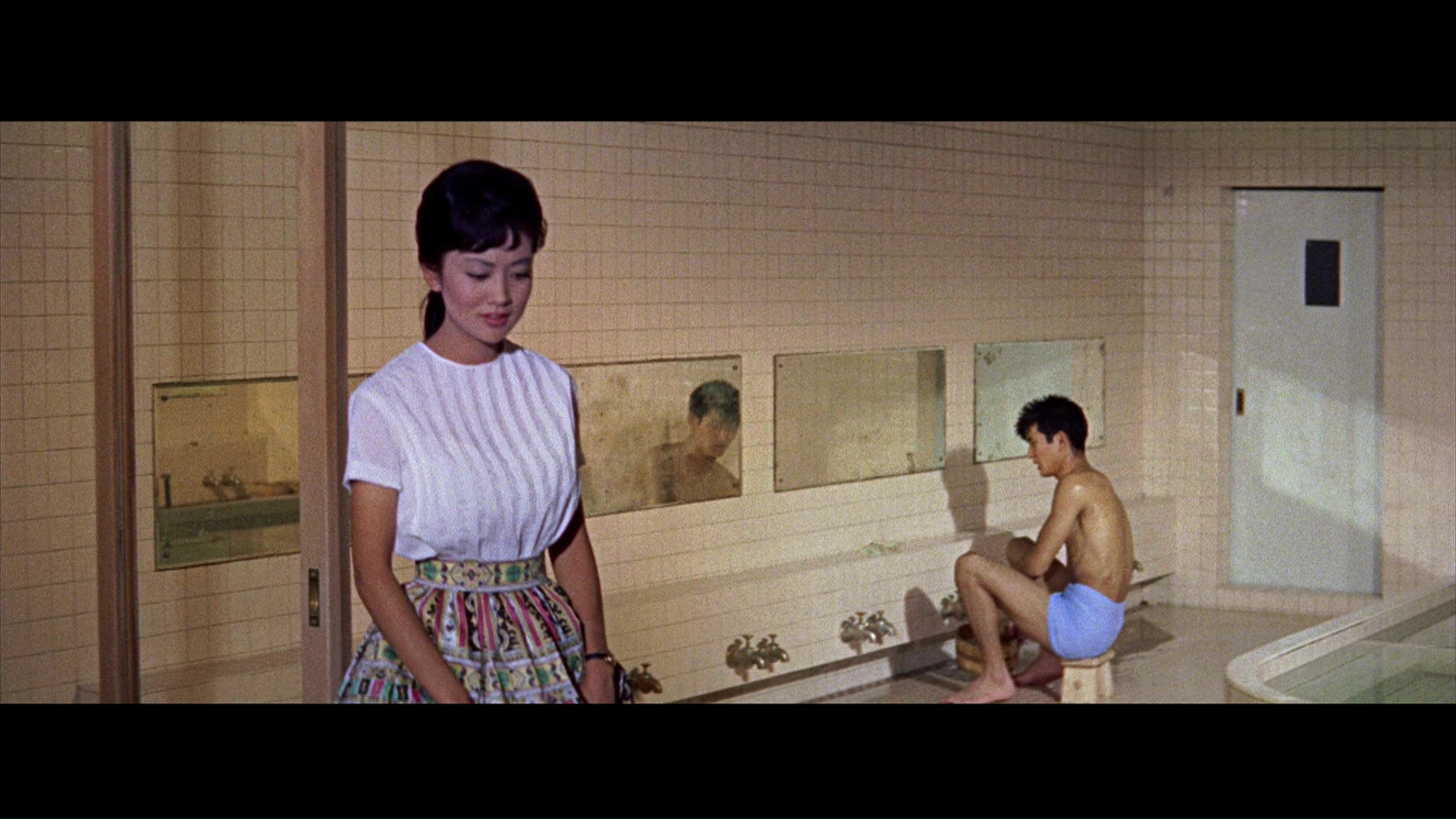 bathhouse proprietress (Asaoka), and one very bad girl (Nakahara). Lots of comic relief, musical numbers (including a bonfire sing-along in the woods), kitchen fights, and tragic melodrama ensue, with Jiro temporarily zipping off through Tokyo and abandoning his dream... but for how long?
bathhouse proprietress (Asaoka), and one very bad girl (Nakahara). Lots of comic relief, musical numbers (including a bonfire sing-along in the woods), kitchen fights, and tragic melodrama ensue, with Jiro temporarily zipping off through Tokyo and abandoning his dream... but for how long? 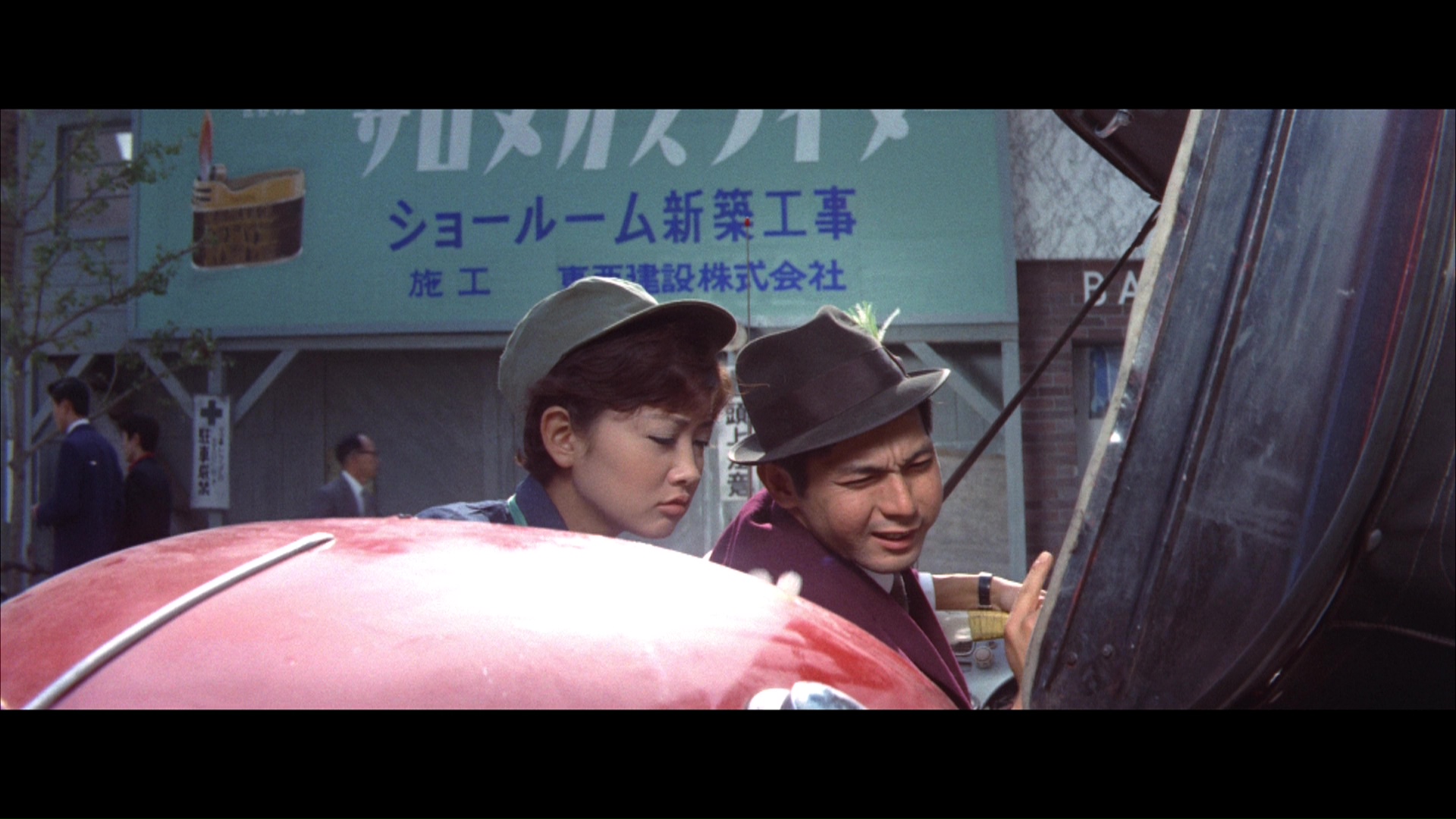
Of course we have to get puffy-cheeked Jô Shishido in here somewhere, and he actually pops up in both of the next features. Danger Pays revolves around the calamity when a huge stash of watermarked money-printing paper gets swiped , enough to generate two billion yen in counterfeit cash. Joe the Ace (Shishido) is the lighthearted, ostensible leader of some low-rent guys, and he comes up with a plan to hook up with a famous counterfeiter. However, everything goes awry in a random string of events that leads to false identities and trips to a nightclub called Club Acapulco where scantily clad girls do splits on a glass floor over the criminals. There's a lot more slapstick here; for example, one character named Glass-Hearted Joe throws a screeching fit when he hears metal or glass being scraped, Joe gets to zip around in a little red mini car, senior citizens cry and freak out, and so on. On the other hand you get some great '60s jazz, colorful fashions and hairdos, and a sweet female badass (Asaoka) who beats up a few of the male cast members.
Finally we hit what will likely be the most divisive film of the bunch, but it's by 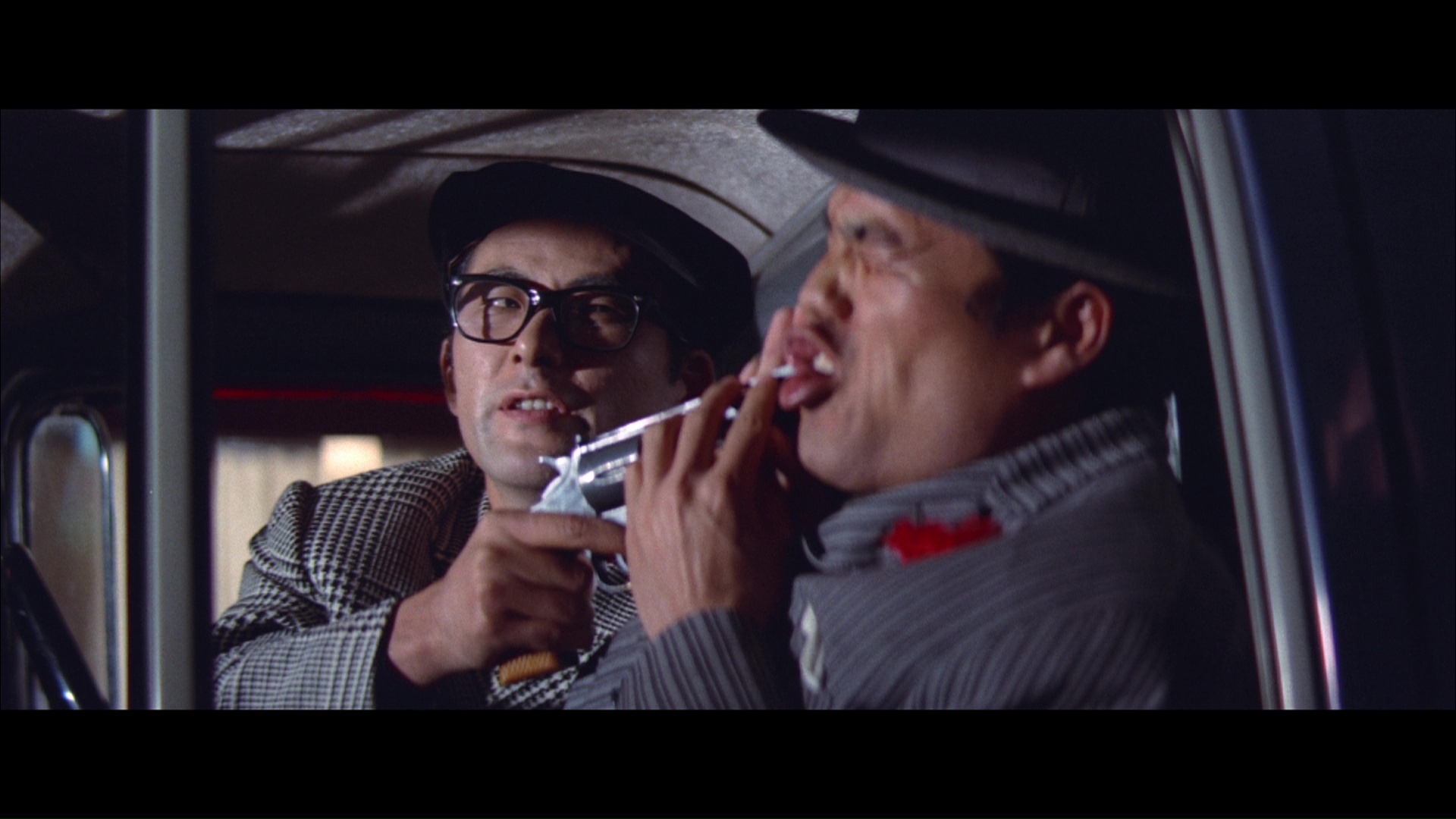 far the favorite of yours truly: Murder Unincorporated, a completely insane black comedy with a ridiculous body count that plays like a drug-addled mash up of The Assassination Bureau,
far the favorite of yours truly: Murder Unincorporated, a completely insane black comedy with a ridiculous body count that plays like a drug-addled mash up of The Assassination Bureau, 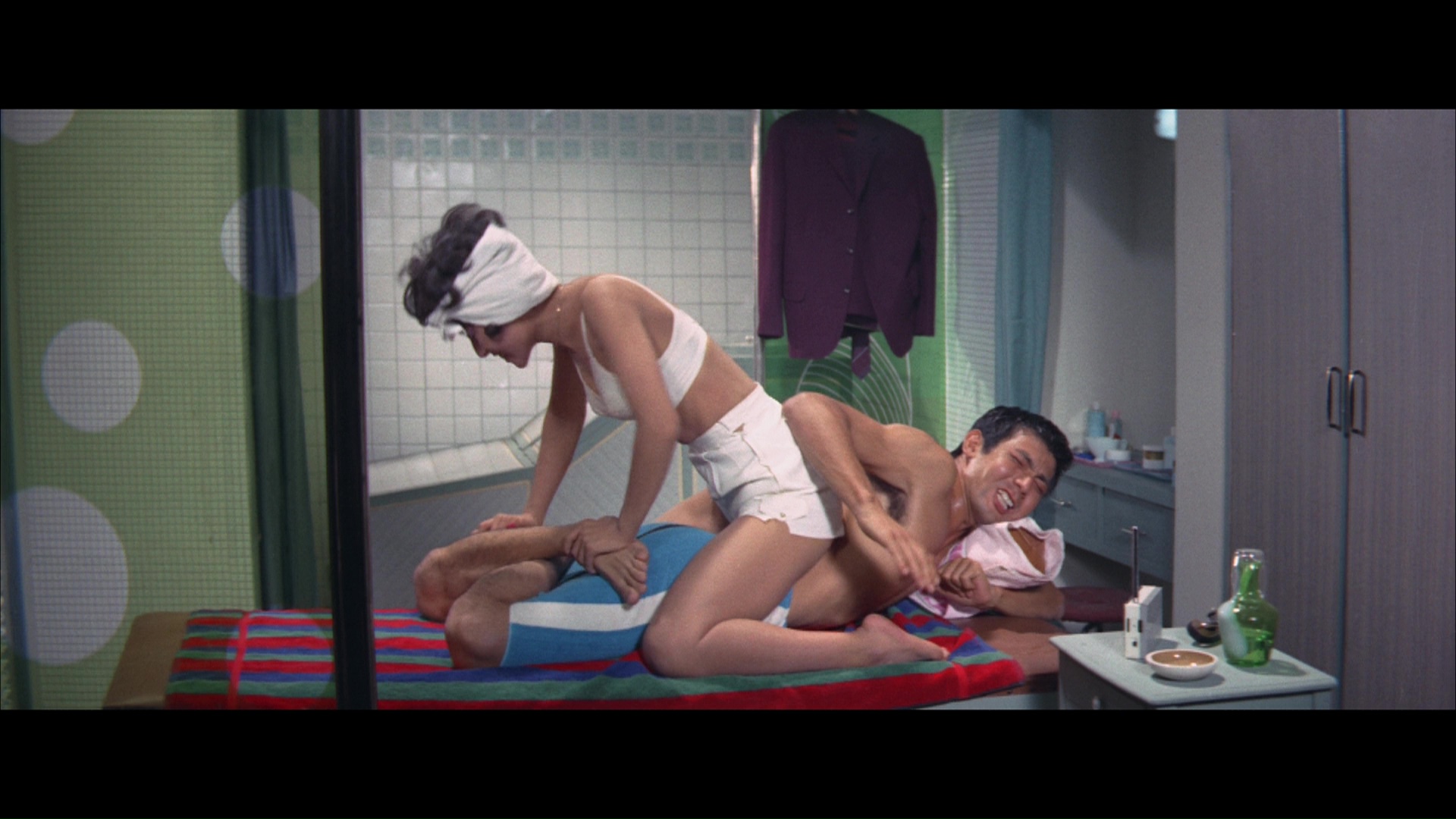 Frank Tashlin, and Mad magazine. In a rough Japanese port town, someone's gunning down criminals starting with big shot Mr. Yoyogi and leaving ripped spade playing cards at the scene. Yoyogi's cohorts, who specialize in drugs, prostitution, and other vices, get other spade cards as a presumed death threat, with the sequence determined the order they'll be taken out. The panicked crooks ring up the title organization, which sends out a call for assassins to take care of business. All of them are eccentric goofballs who come into town via different modes of transportation, and of course, nothing goes as planned as murder attempts backfire, motives get crossed, and Shishido gets to show off his cool sunglasses. You also get some geisha drag comedy, a little boy aspiring assassin (Shiraki) dressed like Oddjob from Goldfinger, a lot of references to poet Heinrich Heine, the most absurd mass assassination scenes before Massacre Mafia Style, and strange commentary about obsessions with baseball and TV violence. More like a string of bizarre comedy sketches than a normal narrative, this one starts off at full volume with a threat to the viewer that they'd better laugh with the movie or get killed, and it never settles down for the remaining hour and a half. The high-pitched performances may irritate viewers unaccustomed to acting pitched this broadly, but it's a fascinating and very entertaining comedy if you're in the right frame of mind.
Frank Tashlin, and Mad magazine. In a rough Japanese port town, someone's gunning down criminals starting with big shot Mr. Yoyogi and leaving ripped spade playing cards at the scene. Yoyogi's cohorts, who specialize in drugs, prostitution, and other vices, get other spade cards as a presumed death threat, with the sequence determined the order they'll be taken out. The panicked crooks ring up the title organization, which sends out a call for assassins to take care of business. All of them are eccentric goofballs who come into town via different modes of transportation, and of course, nothing goes as planned as murder attempts backfire, motives get crossed, and Shishido gets to show off his cool sunglasses. You also get some geisha drag comedy, a little boy aspiring assassin (Shiraki) dressed like Oddjob from Goldfinger, a lot of references to poet Heinrich Heine, the most absurd mass assassination scenes before Massacre Mafia Style, and strange commentary about obsessions with baseball and TV violence. More like a string of bizarre comedy sketches than a normal narrative, this one starts off at full volume with a threat to the viewer that they'd better laugh with the movie or get killed, and it never settles down for the remaining hour and a half. The high-pitched performances may irritate viewers unaccustomed to acting pitched this broadly, but it's a fascinating and very entertaining comedy if you're in the right frame of mind.
All three films are quite fun and should be totally new to most Western viewers, with a combination of surf rock and jazz 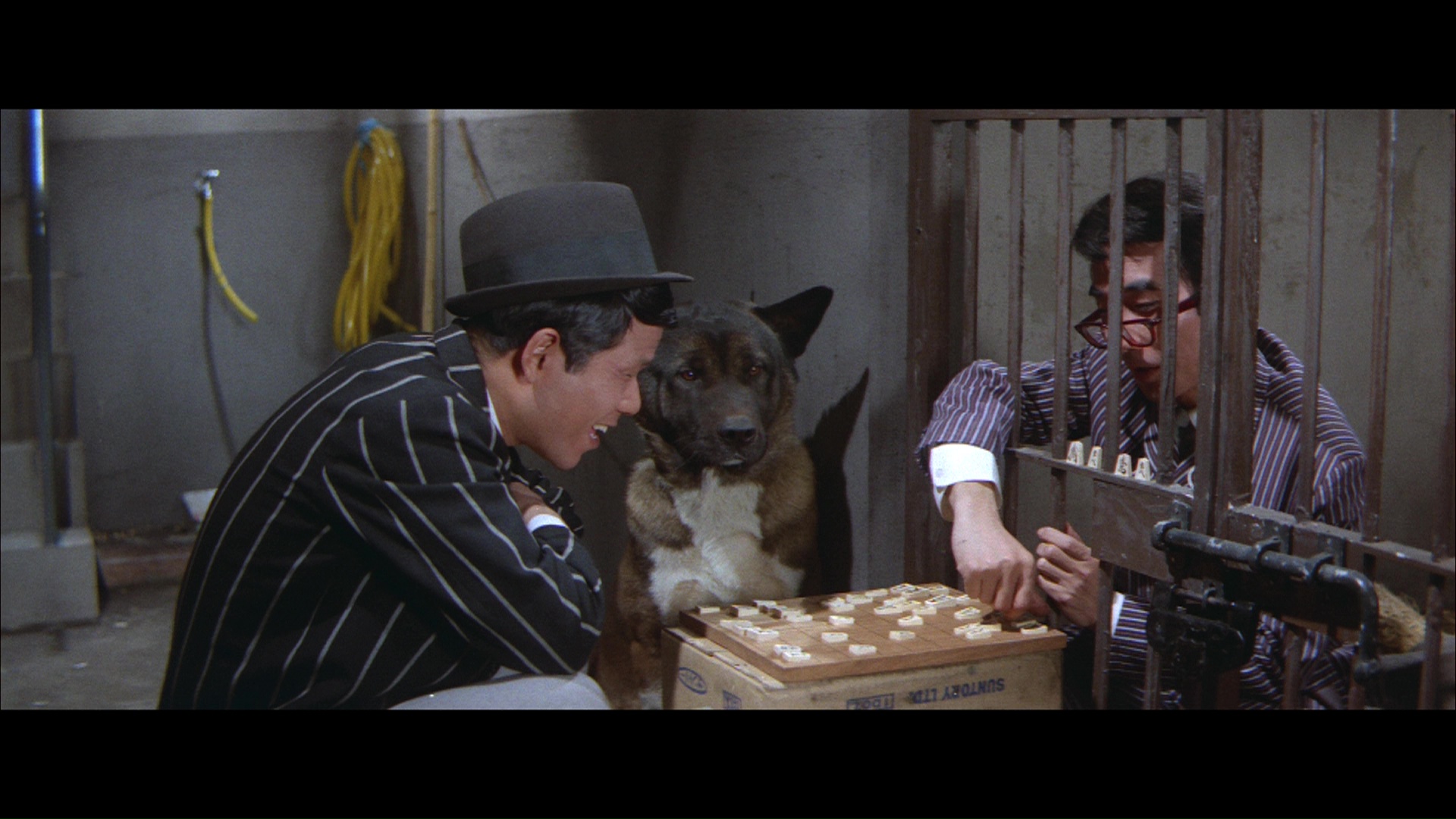 soundtracks and envelope-pushing bare skin popping up at regular intervals. All of them come to Blu-ray looking quite solid thanks to the
soundtracks and envelope-pushing bare skin popping up at regular intervals. All of them come to Blu-ray looking quite solid thanks to the 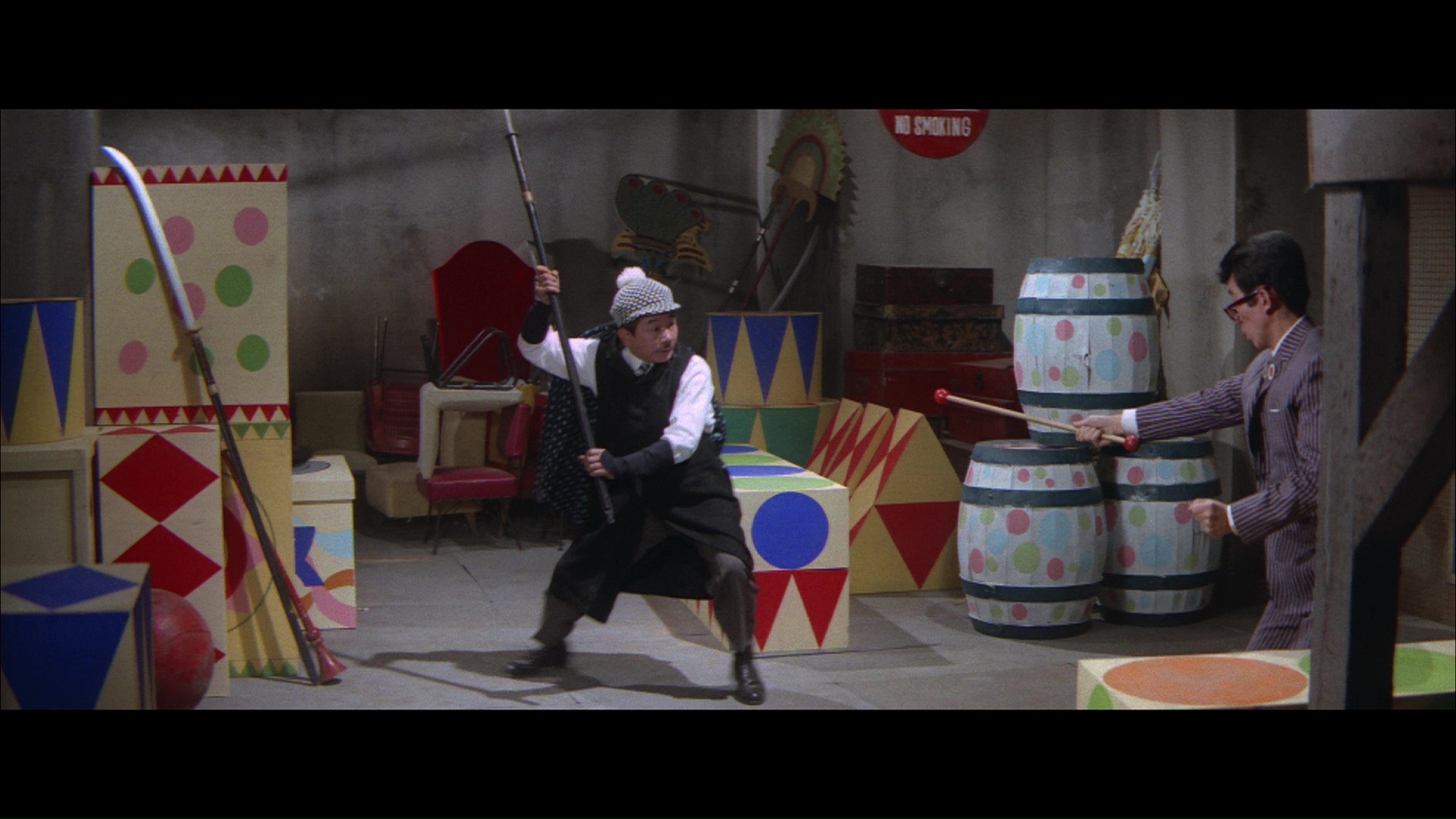 usual care from the Nikkatsu vaults; apart from some slight telecine wobble in a few scenes in the first film, there isn't anything significantly detrimental here (and thankfully no visible splice marks, a frequent annoyance on many older Nikkatsu titles). Danger Pays looks the weakest of the three with a somewhat drab color palette and flat appearance, but all are far better than acceptable and will likely never be seen in better condition than this. The LPCM mono audio (Japanese with optional English subtitles) sounds accurate and pleasing for all three titles as well. As with the previous release, Jasper Sharp offers a pair of useful video discussions about Shishido and Kobayashi (20 mins.) about their matinee idol appeal and the ups and downs of their careers around this period, with Shishido obviously going the stranger route of the two. Incidentally, both Sharp and the Nikkatsu catalog refer to the second film as Danger Paws rather than the title it now bears elsewhere. Also included are trailers for all three films (be warned the one for Danger Pays shows the entire ending!) along with the Outlaw Gangster VIP series, image galleries for all three films, the usual reversible sleeve with a new design by Graham Humphreys, and liner notes by Stuart Galbraith IV, Tom Mes and Mark Schilling. No hints of a third set anywhere in here, but hopefully one won't be too far off.
usual care from the Nikkatsu vaults; apart from some slight telecine wobble in a few scenes in the first film, there isn't anything significantly detrimental here (and thankfully no visible splice marks, a frequent annoyance on many older Nikkatsu titles). Danger Pays looks the weakest of the three with a somewhat drab color palette and flat appearance, but all are far better than acceptable and will likely never be seen in better condition than this. The LPCM mono audio (Japanese with optional English subtitles) sounds accurate and pleasing for all three titles as well. As with the previous release, Jasper Sharp offers a pair of useful video discussions about Shishido and Kobayashi (20 mins.) about their matinee idol appeal and the ups and downs of their careers around this period, with Shishido obviously going the stranger route of the two. Incidentally, both Sharp and the Nikkatsu catalog refer to the second film as Danger Paws rather than the title it now bears elsewhere. Also included are trailers for all three films (be warned the one for Danger Pays shows the entire ending!) along with the Outlaw Gangster VIP series, image galleries for all three films, the usual reversible sleeve with a new design by Graham Humphreys, and liner notes by Stuart Galbraith IV, Tom Mes and Mark Schilling. No hints of a third set anywhere in here, but hopefully one won't be too far off.
Reviewed on June 2, 2016.




 Arrow Films already promised a second volume in its Nikkatsu Diamonds Guys line even before the first one hit the streets, and anyone who indulged in that tasty triple helping of noir mayhem will find this set to be something even wilder and stranger. Picking up with the tone of the previous set’s The Wandering Guitarist, here we have a trio of very colorful, offbeat, and whimsically weird vehicles for some of Nikkatsu’s biggest leading men at the time, with color palettes worthy of classic Technicolor musicals.
Arrow Films already promised a second volume in its Nikkatsu Diamonds Guys line even before the first one hit the streets, and anyone who indulged in that tasty triple helping of noir mayhem will find this set to be something even wilder and stranger. Picking up with the tone of the previous set’s The Wandering Guitarist, here we have a trio of very colorful, offbeat, and whimsically weird vehicles for some of Nikkatsu’s biggest leading men at the time, with color palettes worthy of classic Technicolor musicals.  bathhouse proprietress (Asaoka), and one very bad girl (Nakahara). Lots of comic relief, musical numbers (including a bonfire sing-along in the woods), kitchen fights, and tragic melodrama ensue, with Jiro temporarily zipping off through Tokyo and abandoning his dream... but for how long?
bathhouse proprietress (Asaoka), and one very bad girl (Nakahara). Lots of comic relief, musical numbers (including a bonfire sing-along in the woods), kitchen fights, and tragic melodrama ensue, with Jiro temporarily zipping off through Tokyo and abandoning his dream... but for how long? 
 far the favorite of yours truly: Murder Unincorporated, a completely insane black comedy with a ridiculous body count that plays like a drug-addled mash up of The Assassination Bureau,
far the favorite of yours truly: Murder Unincorporated, a completely insane black comedy with a ridiculous body count that plays like a drug-addled mash up of The Assassination Bureau,  Frank Tashlin, and Mad magazine. In a rough Japanese port town, someone's gunning down criminals starting with big shot Mr. Yoyogi and leaving ripped spade playing cards at the scene. Yoyogi's cohorts, who specialize in drugs, prostitution, and other vices, get other spade cards as a presumed death threat, with the sequence determined the order they'll be taken out. The panicked crooks ring up the title organization, which sends out a call for assassins to take care of business. All of them are eccentric goofballs who come into town via different modes of transportation, and of course, nothing goes as planned as murder attempts backfire, motives get crossed, and Shishido gets to show off his cool sunglasses. You also get some geisha drag comedy, a little boy aspiring assassin (Shiraki) dressed like Oddjob from Goldfinger, a lot of references to poet Heinrich Heine, the most absurd mass assassination scenes before Massacre Mafia Style, and strange commentary about obsessions with baseball and TV violence. More like a string of bizarre comedy sketches than a normal narrative, this one starts off at full volume with a threat to the viewer that they'd better laugh with the movie or get killed, and it never settles down for the remaining hour and a half. The high-pitched performances may irritate viewers unaccustomed to acting pitched this broadly, but it's a fascinating and very entertaining comedy if you're in the right frame of mind.
Frank Tashlin, and Mad magazine. In a rough Japanese port town, someone's gunning down criminals starting with big shot Mr. Yoyogi and leaving ripped spade playing cards at the scene. Yoyogi's cohorts, who specialize in drugs, prostitution, and other vices, get other spade cards as a presumed death threat, with the sequence determined the order they'll be taken out. The panicked crooks ring up the title organization, which sends out a call for assassins to take care of business. All of them are eccentric goofballs who come into town via different modes of transportation, and of course, nothing goes as planned as murder attempts backfire, motives get crossed, and Shishido gets to show off his cool sunglasses. You also get some geisha drag comedy, a little boy aspiring assassin (Shiraki) dressed like Oddjob from Goldfinger, a lot of references to poet Heinrich Heine, the most absurd mass assassination scenes before Massacre Mafia Style, and strange commentary about obsessions with baseball and TV violence. More like a string of bizarre comedy sketches than a normal narrative, this one starts off at full volume with a threat to the viewer that they'd better laugh with the movie or get killed, and it never settles down for the remaining hour and a half. The high-pitched performances may irritate viewers unaccustomed to acting pitched this broadly, but it's a fascinating and very entertaining comedy if you're in the right frame of mind.  soundtracks and envelope-pushing bare skin popping up at regular intervals. All of them come to Blu-ray looking quite solid thanks to the
soundtracks and envelope-pushing bare skin popping up at regular intervals. All of them come to Blu-ray looking quite solid thanks to the  usual care from the Nikkatsu vaults; apart from some slight telecine wobble in a few scenes in the first film, there isn't anything significantly detrimental here (and thankfully no visible splice marks, a frequent annoyance on many older Nikkatsu titles). Danger Pays looks the weakest of the three with a somewhat drab color palette and flat appearance, but all are far better than acceptable and will likely never be seen in better condition than this. The LPCM mono audio (Japanese with optional English subtitles) sounds accurate and pleasing for all three titles as well. As with the previous release, Jasper Sharp offers a pair of useful video discussions about Shishido and Kobayashi (20 mins.) about their matinee idol appeal and the ups and downs of their careers around this period, with Shishido obviously going the stranger route of the two. Incidentally, both Sharp and the Nikkatsu catalog refer to the second film as Danger Paws rather than the title it now bears elsewhere. Also included are trailers for all three films (be warned the one for Danger Pays shows the entire ending!) along with the Outlaw Gangster VIP series, image galleries for all three films, the usual reversible sleeve with a new design by Graham Humphreys, and liner notes by Stuart Galbraith IV, Tom Mes and Mark Schilling. No hints of a third set anywhere in here, but hopefully one won't be too far off.
usual care from the Nikkatsu vaults; apart from some slight telecine wobble in a few scenes in the first film, there isn't anything significantly detrimental here (and thankfully no visible splice marks, a frequent annoyance on many older Nikkatsu titles). Danger Pays looks the weakest of the three with a somewhat drab color palette and flat appearance, but all are far better than acceptable and will likely never be seen in better condition than this. The LPCM mono audio (Japanese with optional English subtitles) sounds accurate and pleasing for all three titles as well. As with the previous release, Jasper Sharp offers a pair of useful video discussions about Shishido and Kobayashi (20 mins.) about their matinee idol appeal and the ups and downs of their careers around this period, with Shishido obviously going the stranger route of the two. Incidentally, both Sharp and the Nikkatsu catalog refer to the second film as Danger Paws rather than the title it now bears elsewhere. Also included are trailers for all three films (be warned the one for Danger Pays shows the entire ending!) along with the Outlaw Gangster VIP series, image galleries for all three films, the usual reversible sleeve with a new design by Graham Humphreys, and liner notes by Stuart Galbraith IV, Tom Mes and Mark Schilling. No hints of a third set anywhere in here, but hopefully one won't be too far off.